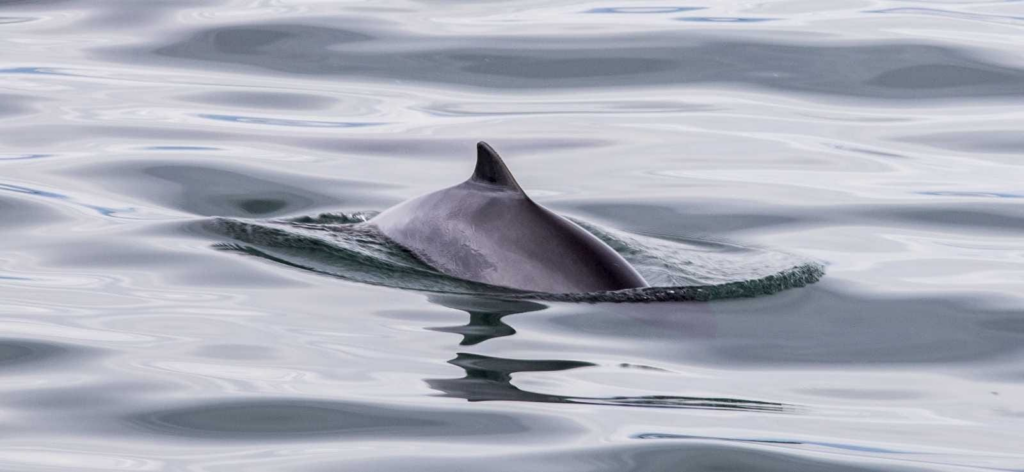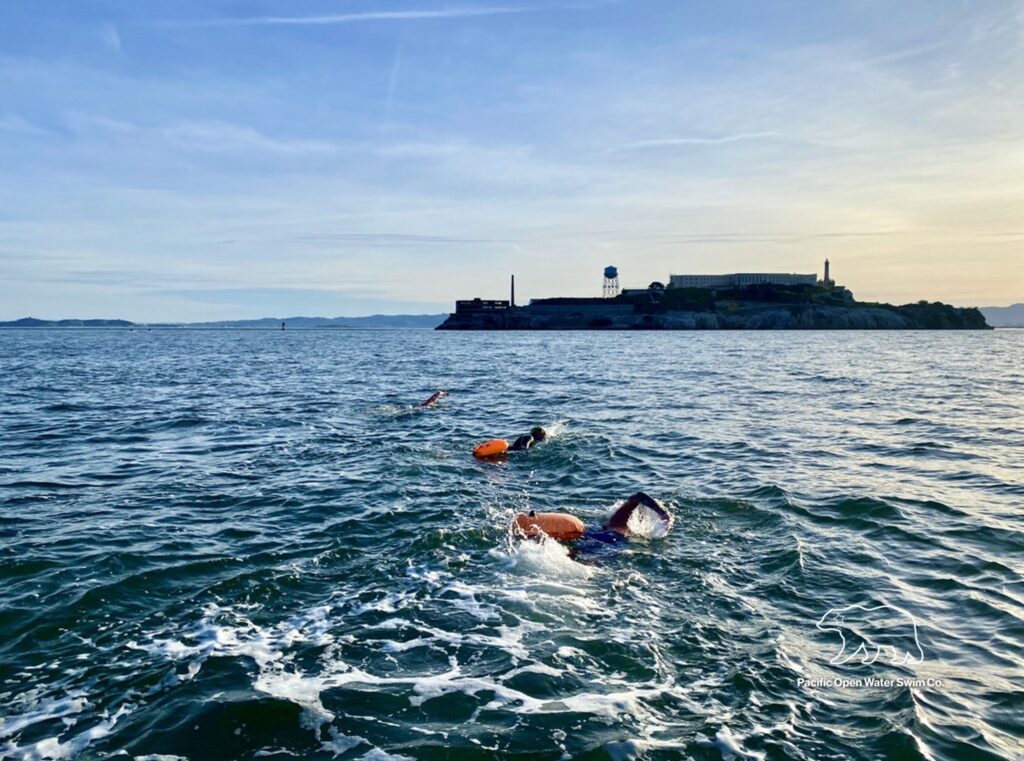Deep Dive Podcast: Sharks and Swimmers in San Francisco Bay and Alcatraz
Cutting through shark myths in San Francisco Bay with facts, history, and firsthand experience. Listen to learn about sharks, swimming, and the hype on your way to the pool, the Bay, or work.
Shark Presence Around Alcatraz: Separating Myth from Reality
People have been swimming in San Francisco Bay for over 150 years. Today, swimming here is more popular than ever, and it’s recognized worldwide as an iconic open-water destination, particularly Alcatraz.
Despite its popularity, myths about “shark-infested waters” persist, fueled by Hollywood films, sensational media portrayals, and dramatic Alcatraz prison tales. With insights from marine researchers and decades of experience swimming these waters, we separate fact from fiction, providing swimmers with a clearer understanding of real versus perceived risks.

One of the biggest hype machines of the last few decades. Discovery’s Shark Week has captivated audiences—and amplified public fear—despite the rarity of shark incidents in places like San Francisco Bay.
The Truth About Sharks in San Francisco Bay
San Francisco Bay does have sharks, but the species commonly found here pose minimal risk to swimmers:
- Leopard Sharks: The Bay’s most common shark species are typically 2-3 feet long. They feed mainly on small fish and crustaceans and are thought to be harmless to humans.
- Sevengill Sharks: These sharks are present primarily in deeper areas and scavenge along the seafloor, rarely interacting with swimmers.
- Thresher Sharks: Found almost exclusively in deeper, offshore waters, making encounters extremely unlikely for swimmers in the Bay.
According to shark researcher Dr. Greg Skomal, smaller shark species prefer shallow, murky environments like those within San Francisco Bay. In contrast, larger predators such as great white sharks favor clearer waters near offshore seal colonies.
Great White Sharks: Rare Visitors to the Bay
Though great white sharks are common along California’s outer coast, confirmed sightings inside San Francisco Bay are rare. Dr. Greg Skomal’s research emphasizes that white sharks prefer clear, offshore waters with dense seal populations—conditions not typical of the Bay’s shallow, murky interior. A few isolated examples have been publicly documented, including a 2015 seal predation near Alcatraz and a fisherman’s 2020 report just inside the Golden Gate that briefly made headlines—underscoring how rare such sightings are, especially given the volume of swimmers and media attention over the years.
Shark Attacks in the Bay: None Confirmed in Over 150 Years
Despite thousands of swimmers entering San Francisco Bay each year, there are no confirmed reports of white shark attacks—or even encounters with swimmers—inside the Golden Gate in over 150 years of organized Bay swimming.
Neither the South End Rowing Club (founded 1873) nor the Dolphin Club (founded 1877) records any such incidents in their histories or oral traditions. This absence is supported by decades of swimmer experience, scientific studies, and marine tracking data.
White sharks are widespread along the California coastline but are rarely seen inside the Bay, where shallow water, low visibility, and minimal seal activity create unfavorable conditions for them.
The only confirmed fatal shark attack in the region occurred in 1959 at Baker Beach—outside the Golden Gate in coastal waters. An 1851 report from Alameda describes an unverified shark-related incident, but it remains speculative and unrelated to swimming.
To date, there are no confirmed reports of shark attacks on swimmers inside San Francisco Bay.
Marine Life Encounters: Common Sightings

While sharks rarely interact with swimmers, the Bay is rich in marine life, including:
- Harbor Porpoises: Small, shy mammals commonly seen in the Bay—often spotted swimming in groups.
- Bottlenose Dolphins: Occasionally spotted passing through in pods.
- Seals and Sea Lions: Typically observed at a safe distance, though between 2019 and 2022, a few isolated sea lion bites were reported at Aquatic Park. Believed to stem from territorial behavior or illness, these incidents were scary for those involved but resulted only in minor injuries with no lasting effects. Sea lions are protected marine mammals and may act defensively if approached or unwell.
- Whales (Gray and Humpback): Migrating whales occasionally come into SF Bay during the spring and fall.
- Jellyfish: Small species such as moon jellies and sea nettles are occasionally present in the Bay. Some may cause mild, temporary stings on exposed skin. These stings are rare, briefly uncomfortable, and typically resolve within an hour or so without further issue.
Pacific Open Water Swim Co.’s Commitment to Safety
At Pacific Open Water Swim Co., swimmer safety is our highest priority. Our safety procedures include:
- Daily evaluations of weather conditions, tides, currents, and maritime activity.
- USCG-licensed escort captains trained specifically in swimmer safety, course navigation, and marine life awareness.
- Comprehensive pre-swim briefings covering swim safety protocols, environmental conditions, and detailed course instructions.

We openly discuss the real but minimal risks of marine life, because no open water environment is entirely risk-free. When our escort vessels spot a seal or sea lion near swimmers, we steer toward it—prompting it to dive and leave. Marine mammals instinctively avoid boats, and this approach consistently prevents interactions. We’ve never had a swimmer incident involving seals or sea lions.
Our role is to support swimmers—not manage wildlife. If a white shark is sighted, the response is simple: swimmers exit the water. While exceedingly rare, this is the only appropriate action.
Ultimately, each swimmer must stay alert, follow instructions, and assess their own fitness, awareness, and readiness for the open water.
Putting Shark Risk into Perspective
Swimmers face significantly higher risks from currents, cold water, or fatigue. Common urban activities, like driving or cycling, and even lightning strikes statistically present greater risks than encountering sharks in the Bay.

Final Thought: The Bay Is Open for Swimmers
Generations of swimmers have safely enjoyed San Francisco Bay. While no open water environment is entirely without risk, understanding actual versus perceived dangers can help swimmers confidently embrace this historic swimming destination. For detailed information and expert insights, swimmers are encouraged to consult reputable resources and professional advice.
DISCLAIMER: This article is for general informational purposes only and does not constitute safety guarantees, legal assurances, or scientific authority. Conditions in San Francisco Bay can vary and may change rapidly. Participants are solely responsible for evaluating their fitness, readiness, and environmental conditions, including the potential risks of marine life, such as sharks, seals, sea lions, and others. By choosing to swim, participants voluntarily assume all inherent risks of open water swimming. Pacific Open Water Swim Co. expressly disclaims any liability for incidents, injuries, or damages related to wildlife encounters. This article does not replace any signed waivers or legal agreements.
SOURCES:
- Skomal, G. (2025). Chasing Shadows. Insights into shark behavior and habitat preferences. Blue Dot Living.
- Frontiers in Marine Science (2021). “Three-Dimensional Movements and Habitat Selection of Young Sharks.” Frontiers.
- Atlantic White Shark Conservancy (2021). “New Research Sheds Light on the Habits of White Sharks off Cape Cod.” Atlantic White Shark Conservancy.
- Save Our Seas Foundation (2024). “Seasonal Predation of White Sharks on Seals.” Save Our Seas.
- Wikipedia (2025). “List of Sharks in California.” Wikipedia.
- Shark Stewards. “Great White Sharks in the San Francisco Bay.” Shark Stewards.
- ABC13 Houston. “How to Protect Yourself from Sharks at the Beach.” ABC13.
- Save Our Seas Foundation. “Greg Skomal – Seasonal Predation and Environmental Conditions.” Save Our Seas.
- Frontiers in Marine Science (2022). “Shark Incidents in California 1950-2021: Frequency and Trends.” Frontiers.
